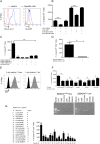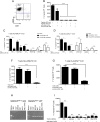T cell neoepitope discovery in colorectal cancer by high throughput profiling of somatic mutations in expressed genes
- PMID: 26681737
- PMCID: PMC5534766
- DOI: 10.1136/gutjnl-2015-309453
T cell neoepitope discovery in colorectal cancer by high throughput profiling of somatic mutations in expressed genes
Abstract
Objective: Patient-specific (unique) tumour antigens, encoded by somatically mutated cancer genes, generate neoepitopes that are implicated in the induction of tumour-controlling T cell responses. Recent advancements in massive DNA sequencing combined with robust T cell epitope predictions have allowed their systematic identification in several malignancies.
Design: We undertook the identification of unique neoepitopes in colorectal cancers (CRCs) by using high-throughput sequencing of cDNAs expressed by standard cancer cell cultures, and by related cancer stem/initiating cells (CSCs) cultures, coupled with a reverse immunology approach not requiring human leukocyte antigen (HLA) allele-specific epitope predictions.
Results: Several unique mutated antigens of CRC, shared by standard cancer and related CSC cultures, were identified by this strategy. CD8+ and CD4+ T cells, either autologous to the patient or derived from HLA-matched healthy donors, were readily expanded in vitro by peptides spanning different cancer mutations and specifically recognised differentiated cancer cells and CSC cultures, expressing the mutations. Neoepitope-specific CD8+ T cell frequency was also increased in a patient, compared with healthy donors, supporting the occurrence of clonal expansion in vivo.
Conclusions: These results provide a proof-of-concept approach for the identification of unique neoepitopes that are immunogenic in patients with CRC and can also target T cells against the most aggressive CSC component.
Keywords: ANTIGENS; CANCER IMMUNOBIOLOGY; COLORECTAL CANCER; GENE MUTATION; IMMUNE RESPONSE.
Published by the BMJ Publishing Group Limited. For permission to use (where not already granted under a licence) please go to http://www.bmj.com/company/products-services/rights-and-licensing/.
Conflict of interest statement
Figures



References
Publication types
MeSH terms
Substances
LinkOut - more resources
Full Text Sources
Other Literature Sources
Medical
Molecular Biology Databases
Research Materials
Miscellaneous
